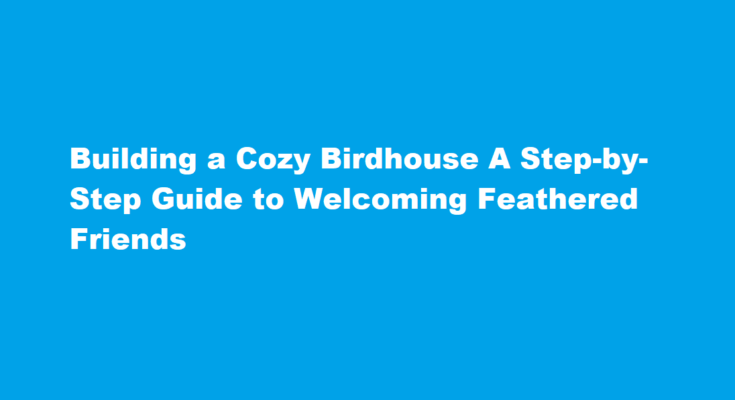Introduction
Birdwatching can be a delightful and rewarding hobby, and what better way to encourage our avian friends to visit our gardens than by providing them with a cozy birdhouse? Building a birdhouse is a fulfilling and enjoyable project that allows us to connect with nature while supporting local bird populations. In this guide, we will take you through the step-by-step process of creating a birdhouse that is not only aesthetically pleasing but also meets the requirements of various bird species. So, let’s grab our tools and embark on this wonderful journey to nurture and protect our feathered friends.
Choose the Right Design
Before starting, decide on the type of birdhouse you want to build. Research the bird species common to your area, as different species have specific preferences regarding the size and design of their nesting spots. For example, bluebirds prefer open-fronted houses, while chickadees prefer houses with small entrance holes.
Gather Materials and Tools
To build a birdhouse, you will need the following materials
- Untreated wood or plywood (cedar or pine are good choices).
- Screws or nails for assembly.
- Waterproof wood glue.
- Hinges or latches for easy cleaning.
- Exterior paint or wood stain (non-toxic and bird-friendly).
- A drill with various-sized bits.
- A handsaw or jigsaw.
- Sandpaper for smoothing edges.
- A measuring tape and pencil.
Measure and Cut
Using the measurements appropriate for the bird species you wish to attract, mark the dimensions on the wood and carefully cut out the required pieces using a saw or jigsaw. The basic components of a birdhouse are the front, back, two sides, and a roof.
Assemble the Birdhouse
Begin by constructing the birdhouse frame. Use screws or nails to secure the back, front, and sides together. Apply waterproof wood glue to the joints for added durability and weather-resistance. Leave one side open for now; this will be the front of the birdhouse.
Create the Entrance Hole
If your chosen bird species requires an entrance hole, now is the time to create it. Use a drill with an appropriate-sized bit to carefully make the hole in the front piece of the birdhouse. Make sure the hole is smooth and splinter-free to prevent injury to the birds.
Add Perches and Roosts (Optional)
Some bird species prefer perches on their birdhouses, while others do not. Research the species you want to attract to determine their preferences. If required, attach a small perch below the entrance hole. Additionally, you can add small roosting bars inside the birdhouse to provide a comfortable resting spot for the birds.
Install the Roof
Secure the roof to the birdhouse frame, ensuring that it overlaps the sides slightly to prevent water from seeping into the interior. This design will help keep the nesting area dry and safe during rain.
Ventilation and Drainage
To ensure proper ventilation, drill small holes near the top of the birdhouse, just below the roofline. These holes will prevent the birdhouse from overheating in hot weather and help reduce moisture build-up. For drainage, drill a few small holes in the bottom of the birdhouse to allow any rainwater to escape.
Painting or Staining
Choose non-toxic, bird-friendly paint or wood stain to protect the birdhouse and add aesthetic appeal. Avoid using bright colors, as they may attract predators. Earthy tones that blend with the environment are ideal.
Mounting the Birdhouse
Select a suitable location for your birdhouse. Mount it on a sturdy pole or hang it from a tree branch, ensuring it is at an appropriate height and away from areas with excessive human activity or potential predators.
FREQUENTLY ASKED QUESTIONS
What wood should I use for a birdhouse?
Ideally, a naturally decay-resistant wood such as cedar, redwood, or a good grade of exterior plywood is best for building birdhouses. Wood should be 3/4″ thick, anything less will allow heat to build up, which is detrimental to young birds. Avoid using paint, especially dark paint, as dark paint absorbs heat.
How deep is a bird house?
Cozy space. Think of a hollow tree; that pocket is snug and deep. Cavity-nesting birds like their houses that way, too; 5 by 5 inches at the bottom is an ideal dimension for most species, with a depth of 5 to 6 inches below the entry and an overall height of 10 to 12 inches.
Conclusion
Building a birdhouse is a wonderful way to contribute to the conservation of local bird populations while enjoying the beauty of nature. By following these steps, you can create a safe and comfortable nesting spot for your feathered friends. Remember to keep the birdhouse clean and well-maintained to attract and support various bird species throughout the seasons. Happy birdwatching!
Read Also : A Green Thumb’s Guide Cultivating Your Own Abundant Vegetable Garden



